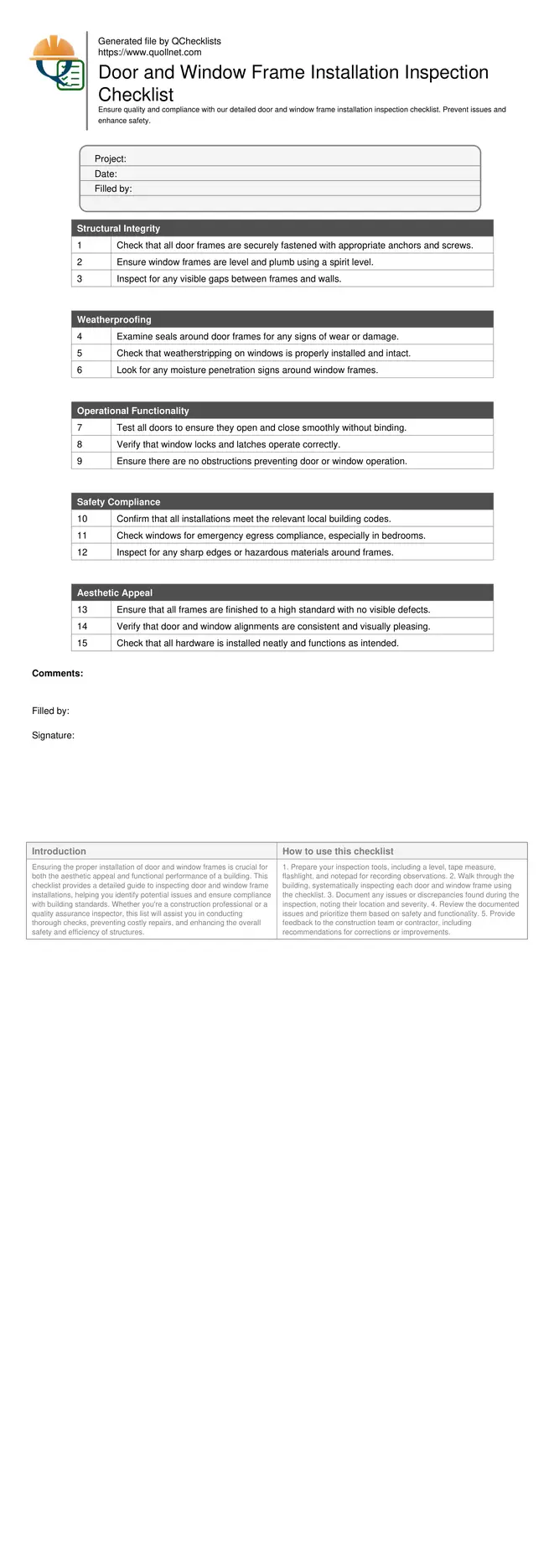Comprehensive Door and Window Frame Installation Inspection
Ensuring the proper installation of door and window frames is crucial for both the aesthetic appeal and functional performance of a building. This checklist provides a detailed guide to inspecting door and window frame installations, helping you identify potential issues and ensure compliance with building standards. Whether you're a construction professional or a quality assurance inspector, this list will assist you in conducting thorough checks, preventing costly repairs, and enhancing the overall safety and efficiency of structures.
- Ensure structural integrity: Verify that all frames are securely anchored and aligned to prevent shifting and ensure durability.
- Check for weatherproofing: Inspect seals and weatherstripping to ensure protection against elements and energy efficiency.
- Verify operational functionality: Confirm that doors and windows open, close, and lock smoothly without obstructions.
- Assess safety compliance: Ensure installations adhere to safety codes and standards, minimizing risks and hazards.
- Enhance aesthetic appeal: Inspect finishes and alignments for a visually pleasing and professional look.
Structural Integrity
Weatherproofing
Operational Functionality
Safety Compliance
Aesthetic Appeal
Importance of Structural Integrity
The structural integrity of door and window frames is vital for the building's overall stability and safety. Properly installed frames prevent issues like warping, misalignment, and drafts. Inspectors should focus on the anchoring systems and the materials used. Frames must be level and plumb to ensure safe and efficient operation.
- Ensure frames are securely fastened and level.
- Check for signs of warping or damage.
- Verify use of appropriate anchoring materials.
- Ensure frames are plumb and aligned.
- Look for any visible gaps or misalignments.
Weatherproofing and Energy Efficiency
Weatherproofing is essential for energy efficiency and comfort. Proper seals and weatherstripping prevent water ingress, air leaks, and heat loss. Inspectors should ensure that all seals are intact and functional, contributing to the building's thermal efficiency and reducing energy costs.
- Inspect seals for cracks or deterioration.
- Check weatherstripping for proper installation.
- Ensure no gaps are present around frames.
- Verify frames are properly insulated.
- Look for signs of moisture intrusion.
Operational and Safety Compliance
Ensuring that doors and windows function smoothly and comply with safety standards is crucial. This includes checking for ease of operation, proper locking mechanisms, and safety features. Inspectors should ensure that installations meet relevant building codes and provide adequate security.
- Test doors and windows for smooth operation.
- Verify locking mechanisms function correctly.
- Ensure installations meet safety codes.
- Check for emergency egress compliance.
- Inspect for any safety hazards or obstructions.
How to Use the Inspection Checklist
- Prepare your inspection tools, including a level, tape measure, flashlight, and notepad for recording observations.
- Walk through the building, systematically inspecting each door and window frame using the checklist.
- Document any issues or discrepancies found during the inspection, noting their location and severity.
- Review the documented issues and prioritize them based on safety and functionality.
- Provide feedback to the construction team or contractor, including recommendations for corrections or improvements.
Call to Action
-
Start Interactive Checklist
Tick off tasks, leave comments on items or the whole form, and export your completed report to PDF or Excel—with a built-in QR code for authenticity.
- Download Excel - Door and Window Frame Installation Inspection Checklist
- Download PDF - Door and Window Frame Installation Inspection Checklist
- View Image - Door and Window Frame Installation Inspection Checklist
